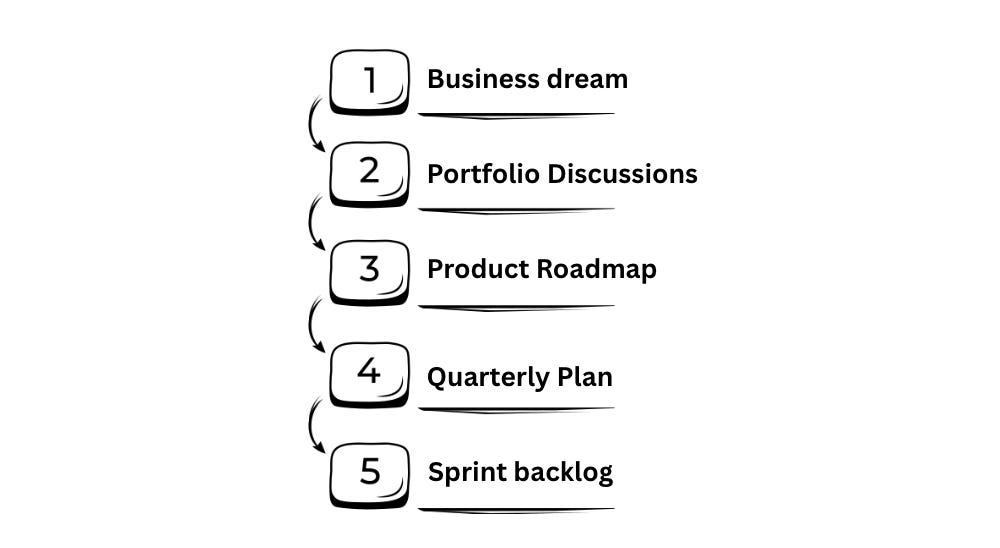“Why is delivery always behind?”
If you’ve been in a Management Team long enough, you’ve heard this question. Big goals are set, the strategy looks sharp on slides, and the plan feels achievable.
But a few months later, deadlines slip, priorities shift, and frustration sets in. Three more months pass, the same thing happens again. Eventually, the strategy itself pivots, and the whole cycle restarts.
The common explanations are familiar: not enough resources, too much tech debt, too many dependencies. All of these can play a role, but they aren’t the root cause.
The deeper issue is the translation gap — the space between the dream at the top and the day-to-day work items at the bottom.
How Strategy Fades on Its Way to the Backlog
Big goals are born in MT meetings and boardroom slides. But while leadership spends its time shaping strategy,
business outcomes don’t live in the boardroom. They live in the backlog.
And the problem is: between the vision and the moment a developer picks up a ticket, the message gets reshaped again and again:
Each step is another round of broken telephone. Clarity blurs. Context gets lost. Sensitive details get softened. Gaps are filled with assumptions.
By the time a backlog item lands with a team, it often barely connects to the original goal. Work gets shipped, but it doesn’t move the business forward. Teams feel urgency — “This needs to be done by tomorrow” — but urgency isn’t the same as impact. Finishing it quickly doesn’t mean it addresses the core issue.
It’s like hitting the edge of the target instead of the bullseye: effort spent, but not full impact.
The result: energy spent, deadlines missed, and business plans slipping. Not because engineers can’t deliver, but because strategy doesn’t survive translation.
Scaling the Waste
When you have one small team, a translation gap might cost you a sprint. Painful, but manageable.
Now picture a company with 100 teams. Each one is a few degrees off. No single team is failing outright, but together those small misalignments snowball into missed quarters and plans.
And the more layers you have, the longer the telephone line gets — and the fuzzier the message becomes. That’s why large organisations often feel slow: the translation gap compounds faster than the company grows.
Culture as a Multiplier
Culture determines whether translation gaps get corrected or ignored.
In transparent cultures, teams feel safe to say: “This doesn’t connect to the bigger goal.” Concerns surface quickly, leaders hear the bad news early, and course-corrections happen before waste piles up. Miscommunication still happens, but it’s smaller and resolved faster. People can commit ambitiously because they know raising risks won’t get them punished.
In cultures of fear, the opposite happens. Progress gets sugarcoated. Promises blur as each layer colours the truth with polished updates instead of directness. Doubts are whispered in hallways, while official updates look safe. Engineers may see the real blockers, but if their voices aren’t welcome, leaders only learn the truth when it’s too late. Rigid, top-down roadmaps make it worse: people commit because they must, and communication turns into spin.
Transparency multiplies alignment. Fear multiplies waste.
The Leader’s Role in Closing the Gap
Leaders often underestimate how much of their job is translation. Setting the vision is only the start. The real work is making sure that vision can survive the long telephone line of portfolios, roadmaps, and backlogs without losing its meaning.
Here are some principles that help close the gap:
1. Fix the culture.
Create psychological safety so people feel comfortable speaking up when things don’t line up. Google’s research highlights psychological safety as the #1 factor in top-performing teams.
Listen carefully, show understanding. Model direct communication yourself by speaking plainly and being clear with the facts you can share. A practical way is to ask openly where things don’t connect and thank people for pointing it out. Group meetings, one-on-ones, or anonymous surveys can all help. When honesty is normalised, issues surface faster.
Way too often I’ve seen teams without psychological safety. Status updates looked polished, but real blockers were not raised. Communication became blurry and expectations drifted away from reality. The result — big delays, frustration and failing plans.
2. Simplify the chain.
Structure and clarity in the operating model are essential, especially as organisations grow. But every extra layer makes the telephone line longer and increases the risk of the strategy getting lost. Too many layers dilute the goal itself.
Be mindful of the balance. Cut unnecessary steps, shorten reporting lines, and give people enough autonomy to make calls without multiple escalations.
Watch out for roles with unclear responsibilities. This leads not only to duplication of effort, but also wasted time spent on alignment rather than progress.
You might have experienced situations where getting approval for a new tool requires five different sign‑offs. By the time the decision comes through, motivation has dropped and the relevance gone.
Simplify the chain. The simpler the chain, the clearer the message stays.
3. Clarity in communication (it is never too much).
A message that feels obvious in the boardroom can become vague two layers down.
Keep repeating goals until they stick. And use a plain and consistent language. Same phrases consistently across presentations, dashboards, and team updates.
Be consistent with terminology too. Business goals should have a clear and stable name. Initiatives should also have names that don’t change from one slide to the next. When labels shift, people get confused. When terms stay steady, the strategy becomes easier to follow.
For example, pin the top three goals to every company-wide deck, and make sure Jira epics or initiatives reference them directly.
Over-communicating clarity is better than letting silence create confusion.
4. Connect work to outcomes.
Backlog items only have real value when they clearly tie to business goals. The connection should be visible across every layer: from business goals to initiatives, from initiatives to roadmaps, from roadmaps to epics, and from epics to backlog items. When this chain is transparent, even the smallest ticket can be traced back to a meaningful outcome.
Explicit traceability is not bureaucracy — it prevents drift and keeps motivation high. People work harder and smarter when they know how their piece of the puzzle contributes to the bigger picture.
Consistency also matters. Use shared terminology across product, business, and engineering. If business calls it a “growth initiative,” product calls it an “epic,” and engineering calls it a “feature,” it causes confusion. It’s best to choose names that resonate with everyone and stick with them.
A practical step: set up your tools so this linkage is easy to see. For example, connect user stories to epics, epics to initiatives, and initiatives to top-level goals in your planning tool. Dashboards that show progress along this chain help leaders and teams speak the same language and see the same outcomes.
5. Keep communication data-driven.
Every time I see metrics and charts in a meeting, the discussion shifts. It becomes more objective, less biased, and less vague. Metrics ground conversations in evidence and make progress visible.
But data is not a replacement for dialogue — it should support it. Numbers need to be interpreted in context. Good leaders ask: What story does this data tell, and does it match what’s really happening on the ground?
When you keep the conversation data-driven, bias and emotions have less room to dominate and decisions become clearer.
Used well, data is a lever that increases alignment and effectiveness. It connects backlog items to real outcomes and helps everyone see whether the work is truly moving the needle.
Closing Thoughts
Delivery doesn’t fail because teams can’t ship. It fails because strategy doesn’t survive the journey from the boardroom to the backlog. The big goals blur, context gets lost, and thousands of small items drift just far enough off course to dilute the outcome.
Perfect alignment will never exist. But every step you take to close the translation gap pays back many times over.
When small backlog items line up with the bigger dream, they create compounding impact. That’s when business dreams start becoming reality.
Enjoyed this read? Subscribe to Lean Product Growth for regular updates on building and scaling a successful product organization.






